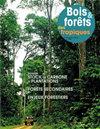Land use impacts on Boswellia dalzielii Hutch. an African frankincense tree in Burkina Faso
IF 0.6
4区 农林科学
Q3 FORESTRY
引用次数: 5
Abstract
Boswellia dalzielii Hutch., an African frankincense tree, is a socio-economically important aromatic and medicinal tree. It is currently threatened by uncontrolled exploitation, and therefore requires action to ensure its sustainable management. This study assessed the population structure and regeneration of its natural stands across three land use types in Burkina Faso: woodlands, fallows and farmlands. Sixty, fifty and fifty 50 m × 20 m plots were established respectively in woodlands, fallows and farmlands. All the plots were surveyed for adult tree (dbh ≥ 5 cm) density, dbh, total height and health conditions. Data on regeneration density (dbh < 5 cm), source (generative, stem shoots, suckers), total height and collar diameter were also collected. The results show similar total tree heights (7.0 m-9.0 m) but significantly (p < 0.05) smaller tree dbh in woodlands (mean ± SD: 20.5 ± 0.49 cm) and fallows (29.3 ± 0.64 cm) than in farmlands (32.8 ± 0.15 cm). Adult tree density (trees/ha) was 1.3 and 2.7 times higher in woodlands (82.37 ± 6.57) than in fallows (62.00 ± 3.98) and farmlands (30.02 ± 1.63), respectively. The density of regeneration in woodlands was 28 and 6 times higher than in fallows and farmlands, respectively. The majority (> 50%) of regenerating plants were suckers and no seedling regeneration was found in farmlands. The distribution of trees in diameter classes was J-shaped in woodlands, bell-shaped in farmlands and positive asymmetric in fallows, indicating recruitment bottlenecks. We found that 80.18% of individuals encountered were unhealthy. Intensive debarking and cutting were the main threats to the species and no conservation strategy was in place in the study region. We suggest measures to reduce intensive debarking and cutting, which should contribute to better management of the species.土地利用对乳香属植物的影响。布基纳法索的一种非洲乳香树
Boswellia dalzielii Hutch。是一种非洲乳香树,是一种重要的社会经济芳香和药用树。它目前受到不受控制的开发的威胁,因此需要采取行动以确保其可持续管理。本研究评估了布基纳法索三种土地利用类型(林地、休耕地和农田)的种群结构和自然林分的更新情况。在林地、休耕地和农田中分别建立60个、50个和50个50 m × 20 m的样地。调查样地成树(胸径≥5 cm)密度、胸径、总高和健康状况。再生植株再生密度(dbh 50%)数据较低,农田无幼苗再生。林木径级分布在林地呈“j”形,在农田呈“钟”形,在休耕地呈正不对称分布,表明存在增补瓶颈。我们发现80.18%的个体是不健康的。频繁的剥皮和砍伐是对该物种的主要威胁,研究区域没有适当的保护策略。我们建议采取措施减少密集的采伐,这将有助于更好地管理该物种。
本文章由计算机程序翻译,如有差异,请以英文原文为准。
求助全文
约1分钟内获得全文
求助全文
来源期刊

Bois et Forets Des Tropiques
FORESTRY-
CiteScore
1.50
自引率
16.70%
发文量
31
审稿时长
>12 weeks
期刊介绍:
In 1947, the former Tropical Forest Technical Centre (CTFT), now part of CIRAD, created the journal Bois et Forêts des Tropiques. Since then, it has disseminated knowledge and research results on forests in intertropical and Mediterranean regions to more than sixty countries. The articles, peer evaluated and reviewed, are short, synthetic and accessible to researchers, engineers, technicians, students and decision-makers. They present original, innovative research results, inventions or discoveries. The journal publishes in an international dimension. The topics covered are of general interest and are aimed at an informed international audience.
 求助内容:
求助内容: 应助结果提醒方式:
应助结果提醒方式:


